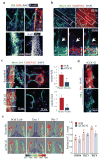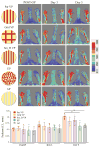3D-printed vascular networks direct therapeutic angiogenesis in ischaemia
- PMID: 29515935
- PMCID: PMC5837070
- DOI: 10.1038/s41551-017-0083
3D-printed vascular networks direct therapeutic angiogenesis in ischaemia
Erratum in
-
Author Correction: 3D-printed vascular networks direct therapeutic angiogenesis in ischaemia.Nat Biomed Eng. 2020 May;4(5):572. doi: 10.1038/s41551-020-0552-7. Nat Biomed Eng. 2020. PMID: 32251393
Abstract
Arterial bypass grafts remain the gold standard for the treatment of end-stage ischaemic disease. Yet patients unable to tolerate the cardiovascular stress of arterial surgery or those with unreconstructable disease would benefit from grafts that are able to induce therapeutic angiogenesis. Here, we introduce an approach whereby implantation of 3D-printed grafts containing endothelial-cell-lined lumens induces spontaneous, geometrically guided generation of collateral circulation in ischaemic settings. In rodent models of hind-limb ischaemia and myocardial infarction, we demonstrate that the vascular patches rescue perfusion of distal tissues, preventing capillary loss, muscle atrophy and loss of function. Inhibiting anastomoses between the construct and the host's local capillary beds, or implanting constructs with unpatterned endothelial cells, abrogates reperfusion. Our 3D-printed grafts constitute an efficient and scalable approach to engineer vascular patches able to guide rapid therapeutic angiogenesis and perfusion for the treatment of ischaemic diseases.
Conflict of interest statement
Competing interests: C.S.C. is a cofounder of, and owns equity in, Innolign Biomedical, a company that is developing tissue engineered products.
Figures




References
-
- CDC, NCHS. Underlying Cause of Death 1999–2013 on CDC WONDER Online Database, released 2015. [Accessed Feb. 3, 2015];Data are from the Multiple Cause of Death Files, 1999–2013, as compiled from data provided by the 57 vital statistics jurisdictions through the Vital Statistics Cooperative Program.
-
- CDC. Deaths, Percent of Total Deaths, and Death Rates for the 15 Leading Causes of Death: United States and Each State, 1999–2014
-
- Mozaffarian D, et al. American Heart Association Statistics Committee and Stroke Statistics Subcommittee Heart disease and stroke statistics-2015 update: a report from the American Heart Association. Circulation. 2015;131:29–322. - PubMed
-
- Fryar CD, Chen TC, Li X. Prevalence of uncontrolled risk factors for cardiovascular disease: United States, 1999–2010. NCHS Data Brief. 2012;103:1–8. - PubMed
-
- Fowkes FG, et al. Comparison of global estimates of prevalence and risk factors for peripheral artery disease in 2000 and 2010: a systematic review and analysis. Lancet. 2013;382:1329–1340. - PubMed
Grants and funding
LinkOut - more resources
Full Text Sources
Other Literature Sources

